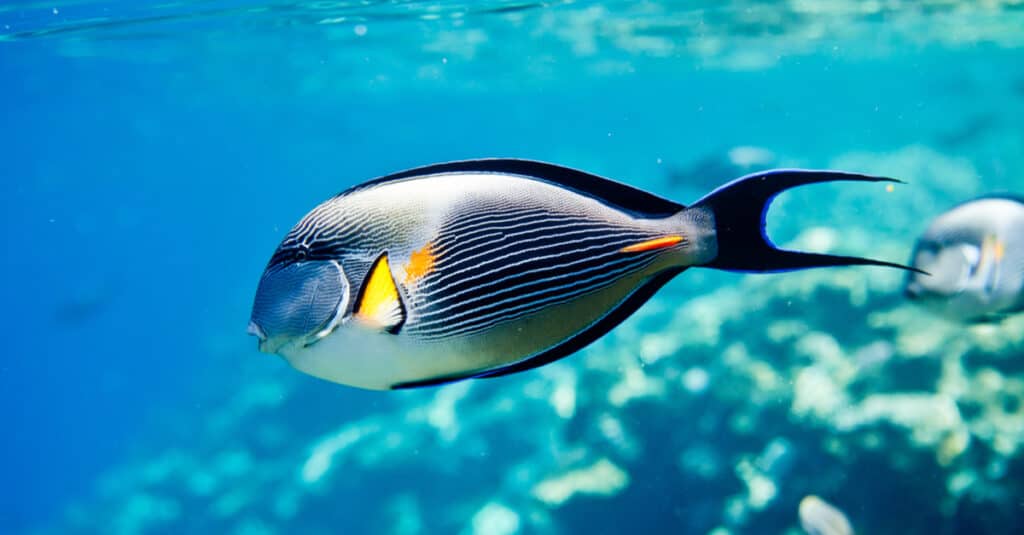Surgeonfish
Paracanthurus hepatus, the palette surgeonfish or bluetang, is the only member of its genus
Advertisement
Surgeonfish Scientific Classification
Read our Complete Guide to Classification of Animals.
Surgeonfish Conservation Status
Surgeonfish Facts
- Group Behavior
- Solitary
- School
- Fun Fact
- Paracanthurus hepatus, the palette surgeonfish or bluetang, is the only member of its genus
- Estimated Population Size
- Though the exact population of surgeonfish is not known, none of these fish appear to be endangered. The overall conservation status is not evaluated.
- Biggest Threat
- Climate change, pollution
- Most Distinctive Feature
- Scalpel-like spines on the side of the tail that can deliver serious cuts
- Other Name(s)
- Tang, doctorfish
- Gestation Period
- 24 hours
- Diet for this Fish
- Herbivore
- Favorite Food
- Zooplankton
- Type
- Fish
- Common Name
- Surgeonfish
- Location
- Warm seas around the world
View all of the Surgeonfish images!
Beautiful, somewhat dangerous cleaner of the coral reef
People admire the surgeonfish, whether it’s a yellowfin, palette, chevron, Achilles or black for its beauty, for many species flaunt jewel-like colors and nearly psychedelic patterns. However, they get their common name because they have an extremely sharp spine like a scalpel near their tail that they use to defend themselves. Though they don’t usually attack humans, a human who annoys a surgeonfish can suffer a serious cut that may need stitches to close up. In the wild these fish serve as a sort of clean-up crew by keeping algae manageable in the coral reefs where they live. They also make good, long-lived pets though you can only have one at a time.
Five Amazing Facts
Here are five amazing facts about surgeonfish:
- Some surgeonfish species have an organ in the gut that’s filled with bits of sand and coral. This helps the fish grind down its food after they swallow it whole.
- Males change colors when they’re ready to breed or fight.
- Surgeonfish genera are largely herbivores with the exception of Naso, the unicornfish. Unicornfish eat plankton.
- Some surgeonfish not only eat algae from rocks and coral but from the bodies of other fish. The blue tang is famous for this cleaning behavior.
Surgeonfish Classification and Scientific name
Surgeonfish belong to the Acanthuridae family. Acanthuridae comes from the Greek words for “thorn” which is akantha, and “tail” which is oura. “Tailthorn” describes the scalpel-sharp spines at the root of the fish’s tail. There are six genera and about 86 species, including the Sohal surgeonfish, the palette surgeonfish, the bluetang, the convict surgeonfish and two fish whose common name is the black surgeonfish. One is Acanthurus gahhm and the other is Ctenochaetus hawaiiensis.
Appearance
Generally, surgeonfish are 7.87 inches to as much as 6.5 feet long, though most grow no longer than 15.5 inches. They have deep but compressed bodies, with eyes found high up on their heads and tiny mouths with finely serrated, spatula-shaped teeth that are perfect for scraping vegetation off surfaces. They have a dorsal fin that runs from the back of the head to the beginning of the tail, and the fin has nine spines. The tail fin is notched but usually lacks a deep fork, though in some surgeonfish the tail is crescent-shaped. Most notable of all, these fish have a tail thorn that is as sharp as a scalpel. It folds into a groove on each side of the peduncle of the tail and can be erected to deter rivals or predators.
These fish can come in a wealth of colors and patterns, and some species change their color as they age. The Achilles tang is mostly black, with areas of beautiful sunset orange, white, and sky blue near the tail. The Red Sea sailfin tang has delicate orange or dark blue bands over its body, with a blue stripe over the eye and areas of polka dots around the head and the tail. The yellowfin surgeonfish has a blueberry gray body, an area of yellow in front of its eyes, and yellow pectoral fins. The blue tang comes in different shades of blue and juveniles are yellow.

Surgeonfish have a tailthorn that is as sharp as a scalpel
©GoncharukMaks/Shutterstock.com
Distribution, Population, and Habitat
Scientists don’t know the exact numbers of surgeonfish, but they are not under threat, and their conservation status is unevaluated. They are found in coral reefs in warm seas around the world.
Surgeonfish Predators and Prey
Besides humans, animals that prey on surgeonfish include eagle rays and fish such as the blue-spotted, honeycomb, and tiger groupers, the longfin African conger, the red cornetfish, and the blacktail snapper, and the yellowfin tuna. Surgeonfish are more likely to be preyed on when they are larvae and form part of the plankton.
Reproduction and Lifespan
The surgeonfish’s reproductive strategies differ from species to species. Some species spawn in huge groups while others simply form pairs. Some males defend harems. However they get together, females release eggs into the water while males release sperm. The eggs are then fertilized and become part of the plankton that drifts on the ocean currents. After this, there is no more parental care.
After about 24 hours an egg hatches into a larva called an acronurus. It is transparent, has no scales, and spends a long time floating in the deep water. As it grows larger it sinks to the bottom of the ocean near the shoreline and turns into a juvenile. Surgeonfish become mature after about one or two years. They are long-lived fish, and there are reports of them living 30 years or longer.
Surgeonfish in Fishing and Cooking
Surgeonfish are not fished for sport. A few species are eaten, even though, like many reef fish, they carry a risk of ciguatera poisoning. Many species make popular pets because of the vividness of their colors and their intelligence. Most species are too aggressive to live with other fish and should be solitary. One exception to this may be the convict surgeonfish.
Population
The population of surgeonfish is not under threat and appears to be stable in the majority of species. But climate change and its effect on the coral reefs where these fish live may ultimately affect their numbers.
View all 293 animals that start with SSurgeonfish FAQs (Frequently Asked Questions)
Why is it called a Surgeonfish?
It’s called a surgeonfish because it has at least one spine that has evolved to be as sharp as a surgeon’s scalpel. These spines are near the root of the tail and fold into the body in many species. You can find where they are because the area is usually a different color than the rest of the fish. For example, the Sohal surgeonfish has blue and white stripes but the area where it keeps its “tailthorn” is orange.
The spine of a surgeonfish can inflict a deep and nasty cut if
Can Surgeonfish hurt you? you carelessly handle the animal.
How do you identify a Surgeonfish?
A surgeonfish has a deep but compact body, a long, uninterrupted dorsal fin, eyes high up on its head, a tiny mouth and a tail that is notched or crescent shaped. There is an area near the peduncle of the tail that houses very sharp spines. These areas are often brightly colored.
Are tangs and surgeonfish the same?
Tangs and surgeonfishes are basically the same type of fish.
What do surgeonfish eat?
When it comes to food, surgeonfish eat algae in the wild. Specifically, they scrape algae off of coral and rocks with their teeth. Some fish scrape their food off of the bodies of other fish, thus doing them the benefit of cleaning them. When it comes to pet surgeonfish, they will take insect larvae or brine shrimp.
Thank you for reading! Have some feedback for us? Contact the AZ Animals editorial team.
Sources
- ITIS / Accessed April 21, 2022
- Georgia Aquarium / Accessed April 21, 2022
- Live Science / Accessed April 21, 2022
- Fish Base / Accessed April 21, 2022
- National Geographic / Accessed April 21, 2022
- Britannica / Accessed April 21, 2022


















